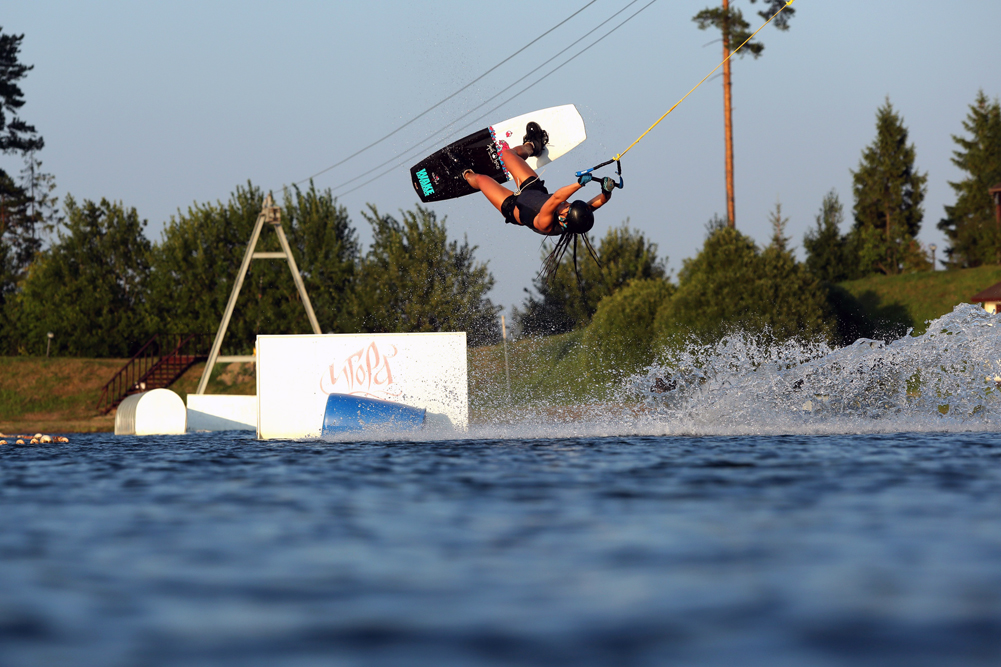Wakeboarding for beginners
Reading time: 6 minutes min
12.03.2021
974
Wakeboarding is a bizarre mixture of water skiing, snowboarding and surfing. This sport is based on acceleration with the help of a motorboat or a mobile unit.
Despite its spectacle and dynamics, wakeboarding is easy to learn. You should have only necessary equipment and training. In addition, this is really a family vacation - children begin to ride from the age of 7-9 years.

What is it?
Wakeboarding is a water snowboard with an assistant in the face of a boat, paraglider or guide mechanism. The athlete holds on to the source of traction with the help of a halyard (cable), performing tricks along the way. The speed is in the range of 25-30 km per hour.
There are three types of wakeboarding, depending on the overclocking method. But the matter is not limited to waves: athletes build structures on the water or on the shore where the board takes on the functions of a skateboard.
Wake parks are equipped with special infrastructure for safe skiing. A similar park is located in the all-season Igora resort.
Types of wakeboarding
Wakeboarding options differ in only one way - the way of overclocking.
- Surface traction - a wakeboarder accelerates using a winch tied to a boat or paraglider. The speed is within 35 km per hour. The boat generates waves and the athlete performs tricks: jumps, somersaults, turns, etc.
- Stationary installations are deployed on the banks of the wake parks. Acceleration is given by rope installations attached to a turntable. Consist of two types: reversible and ring. The first is designed for walking back and forth and the second allows you to drive around the pond in a circle without turning around, moving in one direction. Ring installations are capable of simultaneously working with 10 or more people. For a beginner the reverse option is suitable.
Electrowake is a relatively new invention. The board is accelerated by a motor to a speed of 45 km per hour. Disadvantages can be only the absence of a wave and poor manoeuvrability: in fact, this is a modernised version of a surfboard.
Types of boards
The design of the wakeboard affects the handling and riding style. Every detail matters - from size and weight to the internal structure of the board.
- Bending (Rocker) is divided into continuous one, stepped one and hybrid one. Shape affects water resistance. So, a board with a continuous bend moves smoothly, easily and quickly. The speed and smoothness decreases in proportion to the number of bends but the jumping ability increases. Choose according to your current needs.
- Bottom design concavities and channels determine the position of the board on the water. Dimples affect board lift while channels affect fit and handling. Channels give maximum control in the middle and act as controls on the edges.
- The fins are directly responsible for steering, working with the oncoming flow of water. Fins sitting on the edges are designed to cling to the water. And the location closer to the centre gives maximum stability. The larger the fins- the higher the stability of the movement. Large models are suitable for teaching beginners.
- Weight – The lighter the board- the better as it increases manoeuvrability.
- Width refers to two parts of the board: the nose / tail and the centre (waist). The wider the board in the centre- the less speed and manoeuvrability, but the stability is better. A similar rule applies to the nose and tail, but for handling. Wide options are recommended for beginners.
The choice of board length depends on the weight of the rider.
|
Rider weight (kg) |
Board length (cm) |
|
Up to 45 |
Up to 130 |
|
40-70 |
130-135 |
|
65-80 |
135-138 |
|
75-110 |
140-145 |
|
100 and above |
145 and above |
Wakeboards are also divided according to the level of rigidity and some other parameters.
Basic tricks
The first tricks on a wakeboard were successfully synthesised from elements of water skiing and a skateboard. Own collection has evolved over the years.

- Air Raley - the rider swings the board from side to side in the air.
- 360º - while on the surface of the water, you need to turn 360º, alternating hands while grabbing the handle.
- Toeside Roll to Revert − roll back sideways and then turn 180°, landing in the opposite direction.
- Powerslide - the wakeboard turns 90° on the water, hard braking throws out a fountain of spray.
- Body Slide - The rider rides backwards.
- Backside Butterslide - Turn the board 90° and slide backwards through the water.
- No-Hander (handless) - the handle is clamped between the knees, sliding occurs without hands.
- Perez - Undercuts away from the wave and slides with a 360° rotation on the surface.
- Indy Grab - The rider in the jump holds the edge of the board between his legs.
Stunts require different levels of training and equipment. Some are performed only on reversible installations, while others require a boat.
Required equipment
Wakeboarding is one of the extreme sports. Appropriate equipment is required. Without taking into account the specifics and frivolous preparation, skating can end in injuries.
Boat
A conventional wakeboard boat will not work - a wakeboarding boat has a powerful engine for fast acceleration and a winch mount design. The boats are designed so that they are less likely to break away from the water while moving. This way the waves form better behind the boat.
For reference - hydroscooters will not work either. Due to their low weight, they bounce and fall on the nose, pulling the rider after them under the water. Skating will not work, plus small waves hit hard on the knees.
Bindings
Used to hold the legs while moving. They connect the legs to the board. Bindings are divided into open and closed types.
- Open is the most common type since the size of the leg is approximate and such a mount is removed with a couple of movements. Lack of low stability.
- Closed - similar to ordinary shoes. Requirements are appropriate: must fit in size. Much more stable but more expensive.
When you choose - consider convenience so that the bindings do not rub your legs.
Wetsuit
Restricts arm and leg movement, but essential in cold water. They are divided into two types:
- Dry - designed for water up to -5 °. They fit tightly to the body and do not let water through.
- Wet - summer option. Penetrating into the suit, the water envelops the rider's body in a thin layer to keep warm.
If the water is too cold- wear thermal underwear and neoprene socks under the wetsuit.
Vest
It is divided into sports and rescue. The first ones will not save during an accident but they will protect against water hammer without restricting movement. Rescue one fully meets its name but decently weighs. For children and beginners, the second option is recommended.
Fal
It is the connecting line between a boat and a person. One end is attached to the boat, the rider clings to the handle on the other end. The length of the wakeboarding rope depends on the body of water and the level of the operator. On average, it is 24-25 metres.
Helmet
If concessions are allowed when choosing a vest, then a helmet is a key element of protection. A helmet is required regardless of skill level. You need to choose only water options as they protect your ears and head from water hammer.
Children's wakeboarding
Nothing prevents children from doing this sport. All you need is equipment and training. When you choose equipment, you need to focus on stability and safety. The winch must be at least 25 metres long, the size of the board is selected based on the weight of the child and the helmet must cover the ears tightly.
Tips for Teaching Children
Training begins from the ground. There are simulators for the first acquaintance with the winch, handle, boat tension. You need to learn to control the turns of the handle, the position of the knees and the width of the legs. Training continues until the child learns to practice the correct positions.
- Training on the ground should take place in full gear so that the child gets used to the new load.
- Water needs to be calm and smooth at the first meeting. Learning is best when the wake park is relatively free of people.
- It is not necessary to immediately stand on the water, the bindings are quite suitable for knee pads. It will allow you to get used to the dynamics without the risk of losing balance.
- The maximum speed should not exceed 20-25 km per hour. Otherwise, the child simply will not hold the handle. It is recommended to increase the speed slowly to gradually get used to towing.
- For children from 5 years old, inflatable simulators are sold, they help to feel the water and ride without unnecessary risk.
Come to our park for professional training. The program of Igora resort is designed for both adults and children.
How to start riding?
The basis of training consists of a combination of balance, manageability and control of one's own body. There are no starting conditions, everything is achieved by preparation.
First steps
- The board should be at right angles to the body.
- The heels rest on the edges of the board.
- The handle is held directly on the half-bent elbows for cushioning.
- Get up out of the water behind the winch gradually, and when fully levelled, smoothly turn the board.
- Do not try to turn around right away, get used to the board - reaching the end of the reversible winch, dive into the water.
- Practice your edges by rolling from side to side, then try to turn around.
- Keep in mind - pressing with your front foot speeds up the movement, and with your back foot slows it down.
- The winch has several speeds - increase the speed gradually, as you gain skills.
- Pointing the nose of the board in the direction of travel reduces water resistance.
When an acceptable level of control is reached, you can start performing the simplest tricks: turns, cuts, monosyllabic jumps through the waves.

